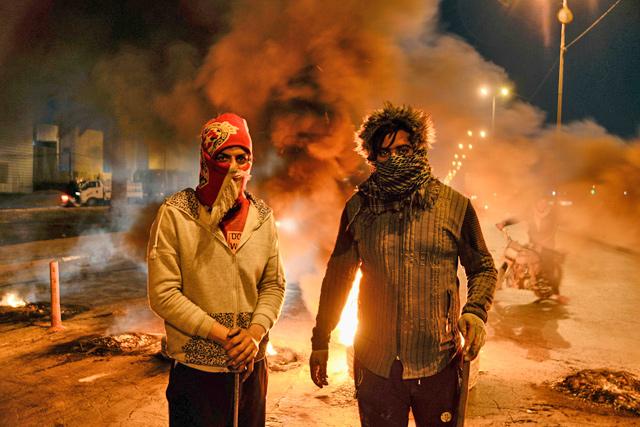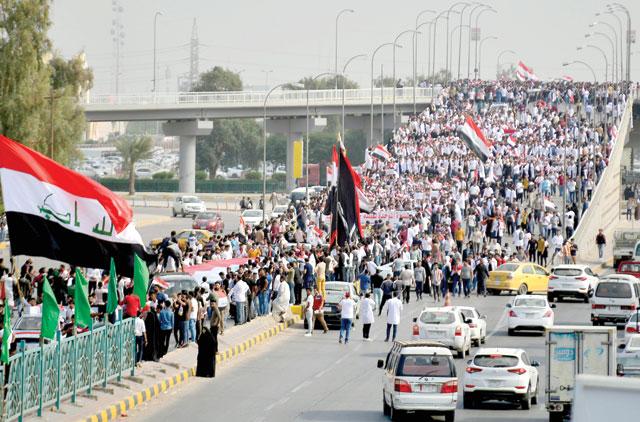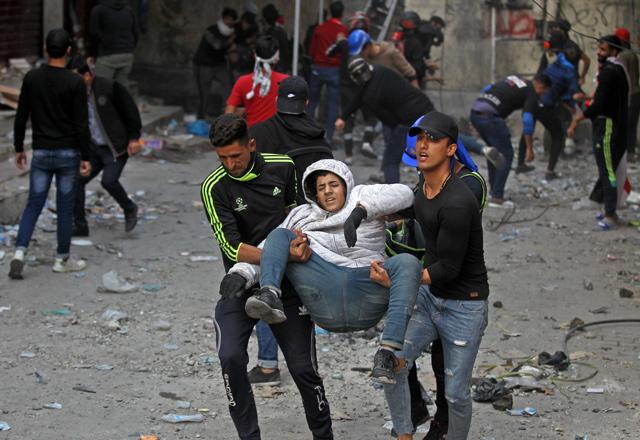You are here
Iraq: Four months of anti-regime protests
By AFP - Feb 01,2020 - Last updated at Feb 01,2020

Masked anti-government protesters stand before flaming tyres at a make-shift roadblock in the central Iraqi holy shrine city of Najaf, on Saturday (AFP photo)
BAGHDAD — Anti-government demonstrations that erupted in Iraq on October 1 have escalated into its deadliest protest movement in decades, with more than 480 dead.
Protests erupt
On October 1, hundreds of people gather in Baghdad and cities in the Shiite south in leaderless protests against corruption, unemployment and poor public services.
Riot police disperse about 1,000 protesters in the capital's Tahrir (Liberation) Square, including with live fire.
The first two demonstrators are killed, one in Baghdad and another in the south.
Protests continue into October 2, getting the backing of influential Shiite cleric Moqtada Sadr, who leads the biggest bloc in parliament.
Unrest spreads
On October 3, thousands defy a curfew in several cities, blockading streets and burning tyres.
Prime Minister Adel Abdel Mahdi defends his year-old government on television, asking for more time to implement reforms.
On October 4, clashes intensify and Sadr calls on the government to resign. Two days later the Cabinet announces reforms including in land distribution, social welfare and anti-corruption.
Deadly second wave
Protests resume on October 24, a day before the anniversary of Abdel Mahdi taking office.
Protesters in the south torch dozens of provincial government buildings and offices linked to the powerful Hashed Al Shaabi paramilitary force.
At least 63 people are killed over two days, according to the Iraqi Human Rights Commission.
On October 28, students, professors and schoolchildren join rallies in Baghdad and southern cities.
Death toll mounts
On November 3, demonstrators in the central city of Karbala attack the Iranian consulate amid charges that Iran is propping up the government. Four are shot dead.
After a major strike and continuing demonstrations, on November 27 protesters torch the Iranian consulate in the holy city of Najaf.
The following day is one of the bloodiest in the uprising, with 46 protesters killed and about 1,000 wounded across the country, including around two dozen in the southern city of Nasiriyah.
PM resigns
On November 29, top Shiite cleric Grand Ayatollah Ali Sistani calls for a new government. Hours later Abdel Mahdi offers to resign.
Parliament accepts his departure on December 1.
Talks to find a new prime minister intensify and include the commander of Iran's Islamic Revolutionary Guard Corps, Major General Qassem Soleimani, a key ally of Iraq's main Shiite parties.
Washington denounces Tehran's "meddling".
Violence escalates
On December 6, at least 20 protesters and four police officers are killed when armed men attack a Baghdad building where anti-government protesters had been camped out for weeks.
After several weeks of calm, protests intensify from December 22.
Parliament votes through electoral reform, which fails to address most of the protesters' specific demands.
Protests resume
On January 10, 2020, thousands of Iraqis rally across the country, reviving the protest movement, which has been overshadowed by tensions between Washington and Tehran after the assassination of Soleimani in a US drone strike.
Thousands of demonstrators seek to shut streets across the country on January 20, clashing with security forces who use live fire.
On January 29, President Barham Saleh threatens to unilaterally name a successor to the premier, if parliament does not nominate a candidate within three days.
Sistani urges free and fair elections "as soon as possible" on January 31. Sadr calls for a "massive" demonstration in Baghdad.
Related Articles
BAGHDAD — Anti-government demonstrations that erupted in Iraq on October 1 have escalated into its deadliest protest movement in decades, co
BAGHDAD — Anti-government rallies swelled in Iraq's capital and south Wednesday as Baghdad faced new pressure from the street, Washington an
NASIRIYAH, Iraq — Iraqis kept up anti-government protests in Baghdad and the south on Saturday, dissatisfied with the premier's vow to quit














